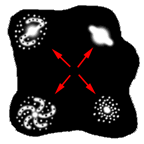 Edwin Hubble is remembered as an astronomer whose discoveries shook
not only the astronomical community, but the whole world. In 1929,
even Hubble was surprised when he realized that all galaxies beyond
the Local Group are receding from the Milky Way, and that more distant
galaxies are receding at faster speeds. The relationship implies
galaxy clusters are flying away from each other. Imagine the shock
when it was announced that the universe is expanding! Indeed, over
ten years earlier, when Einstein's theory of relativity predicted the
universe had to be expanding or contracting, Einstein did not believe
the equations. Einstein created a fudge factor he called the
"cosmological constant" to force his model to represent a static
universe. Einstein later referred to the cosmological constant as the
greatest blunder of his life.
Edwin Hubble is remembered as an astronomer whose discoveries shook
not only the astronomical community, but the whole world. In 1929,
even Hubble was surprised when he realized that all galaxies beyond
the Local Group are receding from the Milky Way, and that more distant
galaxies are receding at faster speeds. The relationship implies
galaxy clusters are flying away from each other. Imagine the shock
when it was announced that the universe is expanding! Indeed, over
ten years earlier, when Einstein's theory of relativity predicted the
universe had to be expanding or contracting, Einstein did not believe
the equations. Einstein created a fudge factor he called the
"cosmological constant" to force his model to represent a static
universe. Einstein later referred to the cosmological constant as the
greatest blunder of his life.The expansion rate of the universe is called the Hubble constant, denoted H. As the expansion rate has varied over the lifetime of our universe, we denote the present-day value of the Hubble constant as Ho. It tells us how quickly galaxy clusters are flying away from each other today. We can estimate the value of Ho from Hubble's Law:
In the simplest use of the Hubble Law, v is the velocity with which a galaxy is receding from the Milky Way galaxy, and d is the distance between the galaxy and the Milky Way. The units of Ho are normally expressed in km/sec/Mpc.
Instead of using the recessional velocity of M100 itself, it is more exact to use the recessional velocity of the center of the Virgo cluster. Individual galaxies within the cluster orbit the center of the cluster, and will have orbital velocities superimposed on their Hubble velocities. Huchra et al. (1995) have found the recessional velocity of the Virgo cluster to be 1396 (+/- 96) km/sec. Write this value on your lab sheet in Section III of your lab sheet:
v = 1396 km/sec
You already calculated the distance to M100 in Section II, Part C. Copy that value over to Section III of your lab sheet:
d = __________ Mpc.
Now divide v by d to obtain the current value of the Hubble constant, and write your result in Section III:
Ho = v/d =___________ km/sec/Mpc
Does your result agree with what you learned in class, or read in your text?
In general terms, think about what it means to use the recessional velocity of the Virgo cluster instead of the recessional velocity of M100. You have not been told where M100 is located within the cluster, or the recessional velocity of M100 itself. Think about how galaxies orbit within a cluster, and how your result might change if you used the recessional velocity for an individual galaxy instead of the recessional velocity of the cluster. How might the size (depth) of the cluster affect the result? Do you think it's sufficient to determine the Hubble constant using only one galaxy in one cluster?
Now that you have an estimate of the Hubble constant, you can estimate the age of the universe!
Back to The distance to M100
Back to the table of contents